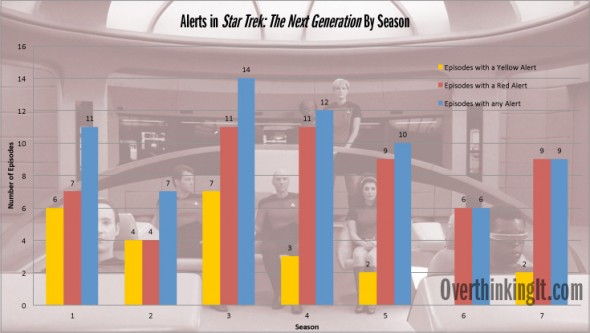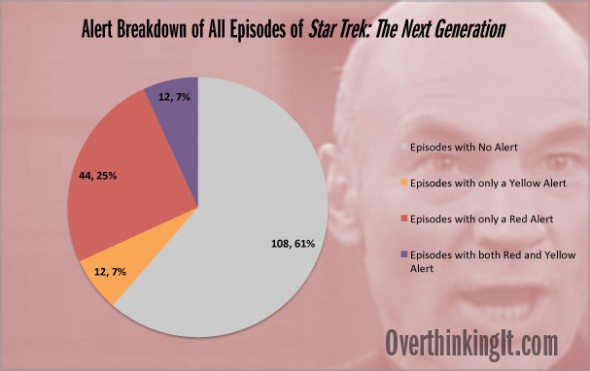You know the feeling. You’re going about exploring the galaxy and performing diplomatic functions on behalf of the Federation when danger and uncertainty start to creep up. Maybe it’s just an anomaly, or a derelict Bird of Prey, or a bad headache. But at some point, the danger makes itself clear, and you have no choice but to signal this to everyone in the least ambiguous terms possible.
Time to go to red alert.
Recently, in the Overthinking It writers’ back channel, we were asking ourselves the question: just how dangerous was it to serve on the Enterprise as depicted on Star Trek: The Next Generation? Weren’t they constantly under attack from Romulans, The Borg, and those nefarious space entities? Or was the Enterprise supposed to be more of a scientific, diplomatic vessel that happened to get into messes from time to time?
To answer that question, we retuned the OTI tachyon beam to analyze transcripts of all 176 episodes, look for occurrences of the phrase “yellow alert” or “red alert,” and categorized each episode by the presence of one or both of these alerts.* It turns out that 61% of all episodes had no alert whatsoever, and that only 32% of all episodes made it all the way to red alert.
This may be more frequent than a typical naval vessel reaches its highest level of alert during an ostensible peacetime mission, but at least for me, it was less frequent than I was expecting, given the amount of peril I remembered the Enterprise encountering.
So with this big picture breakdown in mind, let’s see how those alerts were distributed across the show’s seven seasons and if there were any trends in the prevalence of alerts:
It’s hard to discern any real trend in alerts across seasons from the data, but if there was one, it would go something like this: alerts dipped from Season 1 to Season 2, then jumped up in Season 3, which had the most episodes with an alert among all seasons. From there, Seasons 4-6 saw a steady decrease in episodes with alerts, before the prevalence of alerts spiked in Season 7, the last season.
I can only speculate as to the reasons behind these trends. Maybe after Season 3, Starfleet started sending the Enterprise on less dangerous missons in safer parts of the galaxy. Or maybe Captain Picard, realizing that going to an alert no longer inspired the appropriate level of urgency from his crew, increased the threshold of danger that constituted an alert in order to summon them less frequently. Or maybe the writers got more interested in exploring Picard’s sensitive, flute-playing side at the expense of alarm klaxons and battle stations.

Season 6, Episode 19: “Lessons.” No yellow or red alerts in this episode.
Now, let’s take a look at the trend of alerts with the arc of a season. Did earlier episodes or later episodes tend to have more alerts? I grouped episodes across seasons roughly into quarters and found that episodes in the first two quarters of season were far more likely to have alerts than those in the last two quarters.
Coming up with an in-universe explanation for this is pretty tough (were the Romulans coordinating their attacks for a certain time in the year, perhaps to coincide with new crew rotations from Starfleet Academy?), but an out-of-universe explanation quickly comes to mind: perhaps the show’s producers were concerned with bringing viewers back for new seasons, so they made sure to pack those alerts into the earlier episodes to lure them back. Once they’ve settled back into their weekly routine of watching the show, they’ll be more accepting of episodes with complicated archeology-driven ret-conning.

Season 6, Episode 20: “The Chase.” No yellow or red alerts in this episode, just a setup for people to complain about the movie “Prometheus” almost 20 years later.
We’ve talked about out-of-universe causes for alerts, so now let’s talk about out-of-universe effects of alerts, specifically in the form of Nielsen ratings. In other words, did the presence of a yellow and/or red alert in an episode help boost its ratings?
Probably not.**

As you can see, there’s not much of a correlation between higher alert status within an episode and higher ratings, either by season or as a whole. Not that you’d expect there to be. Can you imagine what the show would have been like if the writers got it in their mind that heightened alert statuses led to higher ratings? The Enterprise would have gone to red alert in practically every episode, which would have left little time for priceless holodeck antics.

Season 6, Episode 8: “A Fistfull of Datas.” I didn’t mean to keep picking on Season 6, it just happened, I promise!
Special thanks to Belinkie for inspiring this article.
*Transcripts were obtained from tvsubtitles.net. Some major caveats in terms of this analysis: this is all based on whether or not the phrase “yellow alert” or “red alert” appeared in an episode or not. So a ship other than the Enterprise could have gone to red alert, and that would have counted as a red alert in this dataset. Also, I was missing the transcript for Season 4, Episode 3. Memory Alpha says that the Enterprise went to “blue alert,” but without having seen the episode, I’m not sure if the phrase “blue alert” is actually spoken or if the Enterprise’s interior lights are just blinking blue.
** Nielsen ratings were obtained from this website, which was missing ratings for several episodes; hence, the gaps in the chart.



Awesome!!! Thank you for this!
It’s nice to see people being as geeky about data and spreadsheets (and Data!) as I am. :)
There’s plenty more where this came from:
http://overthinkingit.com/tag/excel
It seems like the clearest trend is the decline in yellow alerts–they’re pretty common in the first few seasons, only to decline in season 4-5.
I always wondered what yellow alert did I eventually went with the the Bridge Commander explanation (who is not canon I ackowledge) were calling the yellow alert essentially raise shield but doesn’t power up weapon
On another note I think we should check episode of Star Trek (TOS or TNG) were the entreprise actually goes into actual unknown territory compare to the one it goes into place the Federation already control.
I always though that for an exploration spaceship they went often to familiar location
It’s not cannon, but in one of the novels, they explain that early scout ships go out and chart all the planets, then exploratory vessels go through and actually do the in-depth work of visiting worlds, making first contact where appropriate, beaming down to get caught up in the episode of the week, etc. Since Enterprise fit the latter category, all of their exploration would be in areas Starfleet knows about and has staked a claim in, but areas that haven’t really been explored in-depth.
If there was any ratings effect wouldn’t it pop up on the subsequent episode rather than the one where the alert occurred? At the very least it would be worth checking.
This data set is flawed in determining the danger of serving on the Enterprise D. It assumes that what we see on the episodes tracks every day of life, when actually it is more likely that hours, days, weeks, or months of boring and safe activity is occurring between episodes, just check the star dates. This is Star Trek not 24. Even the final seasons of ST:DS9, with its massive arc Dominion War, jumped time between episodes. The writers are generally only going to tell us the interesting events of life on the Enterprise and its crew. It is much like reading the biblical book of Judges. A quick read might lead one to think that these people were constantly at war, but when the reader considers the internal calendar of the book, there are more years of peace than times when the judges are making war against Israel’s enemies.
You bring up a good point; it had not occurred to me to use stardates to measure the in-universe passage of time between episodes/seasons. Then we could measure the frequency of red alerts according to in-universe time, as opposed to seasons/episodes.
Does 1 season of the show roughly equate to one Earth year in ST:TNG time?
I’m a trek fan, but I’ve never calibrated ST time to real time. I do know that the original idea for ST:OS was they were on a “5 year mission” and each season was supposed to be a year.
I would think that an easier time gauge for much of ST:TNG would be to use the children (Wesley Crusher and Alexander Rozhenko), as they show age and grade development. You certainly can’t use Worf’s hair growth rate as it can grow quickly between seasons.
One season does correlate to one calendar year, according to Memory Alpha. Curious that a lot of bad mojo always seems to go down right around New Year’s.
This was really fun to read!
The numbers in the pie chart are messed up (108% of all episodes without any alert??). Does pointing this out count as a “Well, actually…” ?
I believe 108 is the number of episodes with no alerts. 61% is the percentage.
Okay, I guess that backfired.
Ron D. Moore once commented that one of the prime directives (one of many with which he disagreed) given to the TNG writers room was that every episode had to place one or more of the main characters in mortal peril. I believe that holds true through pretty much every episode of all other Trek series, so I’d say serving in Starfleet is pretty dangerous.
I mean, that makes sense doesn’t it? We’re watching years in the life of this ship, there’s a lot of boring soil sampling that we probably don’t get to see. If you were putting together the highlight reel of the Enterprise for omnipresent watchers, that’s the kind of stuff you’d be looking for.
I would think the highlight reel of the Enterprise would be the times that they discovered something fascinating and wondrous, improved a culture or even an individual’s life, or perhaps learned a valuable lesson about the limits of their power. None of these things require them to be in any physical danger, necessarily, although in some cases they would be.
I might remember incorrectly but wasn’t the phrase “condition yellow” very rarely used instead of yellow alert?